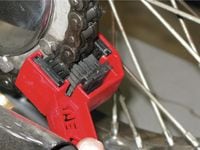Throughout motorcycling’s evolution toward more sophisticated technology, one feature of the earliest motorcycles still hangs in there like a vestigial tail––the drive chain. Simple––if not downright crude––yet efficient, it’s essentially a long string of machined bearing surfaces that lives in a harsh wilderness of water, dirt, infrequent adjustment, and insufficient lubrication. Beneath its often greasy exterior lie vital clues to ensuring its survival and longevity.
Virtually all drive chains for street bikes, dirt bikes, and ATVs use some sort of flexible ring to seal grease in the gap between the pin and the bushing, where the load on the chain is highest. The first such seals were called O-rings because their cross-section is round, but now some chain manufacturers use rings whose cross-section resembles an X or a Z. When a solid O-ring is compressed between the side plates it puts pressure on the chain joint, and can wear into the side plate over time. X- and Z-rings bend or twist when they’re installed between the side plates, so they put less pressure on the joint, wear more slowly, and seal better.
If the sealing ring breaks, the grease leaks out and that particular joint heats up, dries out, and becomes contaminated with water and rust, elongating the pin-to-bushing fit. (Chains don’t actually stretch; their internal clearances just get bigger.) This puts more load on the adjacent joints, and on the sprocket teeth. Sealing rings rarely break, but if they do, you should consider your chain toast; it’s time for a new one.
Savvy maintenance is the key to chain survival. Never clean a chain with a wire brush. Instead use a commercial chain brush (or worn-out toothbrush) to gently remove dirt from the space between the side plates and around the sealing ring. Use kerosene as a solvent, or an all-surface cleaning product like Simple Green, or a dedicated chain-cleaning solution approved for O-ring chains. Never use gasoline. (In a pinch, you can employ WD-40 as a cleaning solvent, but it’s more expensive than using kerosene.) And don’t even think about cleaning the goo off your chain with the high-pressure hose at the car wash. A strong stream of water will blow right past the sealing ring and force out the grease.
The grease behind the sealing ring is meant to last the life of the chain, but you still need to lubricate the chain rollers, which contact the sprocket teeth, and the sealing rings themselves, which can otherwise dry out and crack. Apply lube into the tiny gap on either side of the roller so it penetrates into the space between the roller and the outside of the bushing, then hit the sealing rings on either side of the chain. Do this when the chain is warm so the lube penetrates under the rollers thoroughly and spreads over the sealing rings. Wipe off the excess lube to keep dirt and grit from sticking to the chain. The chain should feel slightly oily to the touch, but not wet.
How often to lube a chain depends on how and where you ride. Every other tank of gas should work for streetbikes; more often for, say, dual-sports ridden off-road. Aerosol chain lube is the most convenient, and the most common. It consists of lubricant in a solvent that thins it out so it penetrates more easily. The solvent quickly evaporates leaving behind a thicker lubricant that’s more of a grease than an oil. But word around the back door of the shop is that regular 80-weight gear oil will do fine. In emergencies you can even transfer oil from your engine’s oil-filler hole to the chain using a screwdriver––just don’t drop it in the crankcase. (That’s the sound of your friends with shaft-drive bikes chuckling.)
Check the chain for slack every time you lube it, and adjust it on an as-needed basis. Some manuals say to do this with the bike on the sidestand, others on the centerstand. If you don’t have the manual, use this racer’s trick: Compress the rear suspension until the rear axle, the swingarm pivot, and the countershaft are lined up. Adjust the chain so there’s 10-15mm slack, then release the suspension and check the slack again. That’s the figure to shoot for next time you adjust the chain with the bike on the stand. Just make sure you use the same stand every time.
Quick Facts
MotoGP and World Superbike racers use sealed chains like the ones on your bike, except with much thinner sealing rings. But it’s not for lower drag. Using a thick seal on either side of the chain requires a longer pin. The ends of the pin, unsupported by the bushing, can bend under the tremendous power of a race engine. Thinner seals allow the use of shorter, stronger pins.












/cloudfront-us-east-1.images.arcpublishing.com/octane/HXOUJXQWA5HBHGRO3EMJIGFMVI.jpg)

/cloudfront-us-east-1.images.arcpublishing.com/octane/3TIWWRV4JBBOLDVGRYECVVTA7Y.jpg)
/cloudfront-us-east-1.images.arcpublishing.com/octane/KIX5O23D5NAIBGFXBN3327DKZU.jpg)
/cloudfront-us-east-1.images.arcpublishing.com/octane/7GJYDUIPXRGMTMQKN6ONYOLBOU.jpg)
/cloudfront-us-east-1.images.arcpublishing.com/octane/MUQLOVLL2ZDGFH25ILABNBXKTI.jpg)
/cloudfront-us-east-1.images.arcpublishing.com/octane/TNOU5DNE2BC57MFPMGN2EIDXAM.jpg)
/cloudfront-us-east-1.images.arcpublishing.com/octane/GTCXACQGJ5HAPDTGWUQKDEH44E.jpg)
/cloudfront-us-east-1.images.arcpublishing.com/octane/S35YGSEMEZB4BLTDJTSZPF4GLA.jpg)
/cloudfront-us-east-1.images.arcpublishing.com/octane/5UOT6HPX2JFMRJAX6EH45AR4MQ.jpg)
/cloudfront-us-east-1.images.arcpublishing.com/octane/OKWOJWAKP5EP3OACCRRWPCIX2Q.jpg)
/cloudfront-us-east-1.images.arcpublishing.com/octane/2WF3SCE3NFBQXLDNJM7KMXA45E.jpg)
/cloudfront-us-east-1.images.arcpublishing.com/octane/G4MG6OUCJNBSHIS2MVVOTPX65E.jpg)
/cloudfront-us-east-1.images.arcpublishing.com/octane/IIGGWFOTOJGB7DB6DGBXCCMTDY.jpg)
/cloudfront-us-east-1.images.arcpublishing.com/octane/QSTCM6AVEZA5JJBUXNIQ3DSOF4.jpg)
/cloudfront-us-east-1.images.arcpublishing.com/octane/U4I7G625B5DMLF2DVIJDFZVV6M.jpg)
/cloudfront-us-east-1.images.arcpublishing.com/octane/B6XD6LS6IVCQPIU6HXDJSM3FHY.jpg)
/cloudfront-us-east-1.images.arcpublishing.com/octane/ICL63FEDDRDTTMINYICCEYGMDA.jpg)
/cloudfront-us-east-1.images.arcpublishing.com/octane/FCGZHQXRBZFLBAPC5SDIQLVF4I.jpg)
/cloudfront-us-east-1.images.arcpublishing.com/octane/WNOB6LDOIFFHJKPSVIWDYUGOPM.jpg)

/cloudfront-us-east-1.images.arcpublishing.com/octane/X33NU3E525ECRHXLNUJN2FTRKI.jpg)
/cloudfront-us-east-1.images.arcpublishing.com/octane/6KKT5NNL2JAVBOXMZYS5ZO76YA.jpg)
/cloudfront-us-east-1.images.arcpublishing.com/octane/J5RKG5O455GMPGQRF2OG6LRT7A.jpg)